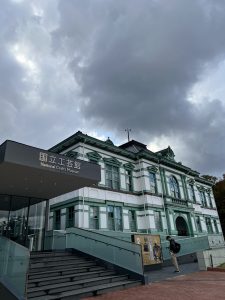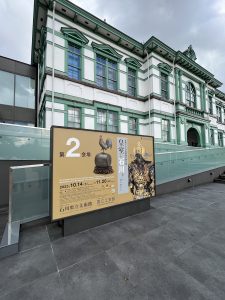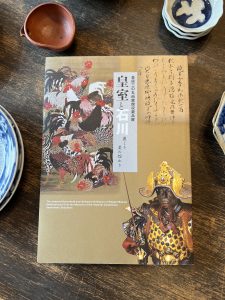若冲をみたい方、今です。(愛知県名古屋市千種区姫池通 骨董買取 古美術風光舎)
2023.10.26
みなさまこんにちは、スタッフYでございます。
先週、里帰りの道中少し寄り道をしまして、金沢の国立工芸館へ行ってまいりました。


かなり急いでましたので、観光などはぶっ飛ばして、立ち寄ったのは国立工芸館のみ。いかにも自分らしいのですが、今回の目的はこの皇居三の丸尚蔵館収蔵品展「皇室と石川」であります。
また、ちょうど金沢市内に天皇ご夫妻がいらっしゃったようでして、市内は警備なので大騒ぎでもあり、観光は難しかっのも正直なところでありました。やはり観光シーズン、人が多かったですね。
そんな、皇居三の丸尚蔵館収蔵品展「皇室と石川」ですが、今回是非拝見したかった若冲の「動植綵絵」であります。
みなさまご存じ若冲ですが、記憶に新しいところですと、2016年に東京都美術館で開催された「生誕300年記念 若冲展」には、なんと40万人以上の来場者を動員するなど記録的な大ブームを起こし大変話題となりました。SNSで話題になったり、TVなどで特集が放映されたりと当時は大騒ぎでしたね。
今回、私が拝見できたのは「動植綵絵」の中のあの有名な「群鶏図」。それはそれは大変有名な絵ですよね。
その「動植綵絵」(どうしょくさいえ)の補足情報を少しいたしますと、伊藤若冲(いとう じゃくちゅう)が江戸時代中期にあたる宝暦7年頃(1757年)から明和3年(1766年)頃にかけて制作された33幅からなる日本画であります。動植物を描いた彩色画のことでして、もともとは臨済宗・相国寺にあったもでありました。
当時は毎年6月17日に厳修される「観音懺法会」の折に、これら33幅を掛けて参拝者に一般公開し参道は出店が立ち並ぶほど賑わったといわれておりましたが、明治時代の廃仏毀釈の波で窮乏した時期の明治22年(1889年)3月「釈迦三尊」3幅だけは寺に残し、若冲の寄進状と売茶翁の一行書と共に「動植綵絵」30幅は明治天皇に献納されました。この時の下賜金1万円のおかげで、相国寺は1万8千坪の敷地を維持できたとのことです。
皇室御物となった「動植綵絵」は、重要な賓客を迎える際の装飾としてその都度使用され、その力強い描線と濃彩は明治宮殿の洋風の内装とも好く調和したそうでして、確かにこの絵が宮殿に飾られ樋高と想像しますと、似合いそうですね。
その「動植綵絵」の中でも13羽の鶏を描いたあの大変有名な「群鶏図」が、展示されるということで、爆速でやってまいりました。

こちらは、エントランスのパネルの写真を撮らせていただいたものです。
渦巻くような羽の模様、真っ赤なトサカ、何かを凝視するような目つき、鶏同士の鮮やかなコントラストが、生々しいほどのリアルさを感じさせますね。禍々しいほどに写実的で、だけれども色の鮮やかさや強い自我を持ったような鶏の表情は現実以上に美しくて、ほんとうに不思議な絵です。一度見たら忘れられないのですから。
それにしても鶏冠を頼りに数えてみると十三羽。もしかしたら、他の鶏の陰に隠れているのが他にもいるかもと思わせるほど、この絵は13匹以上の込み入った印象を与えます。個々の鶏の頭部と胴体とがどうつながっているのか一見してわからないところがあり、これはトリックなのか。
また、鶏はすべてほぼ水平の視線から描かれているのですが、地面に描かれている草を見ると斜め上から見下ろした視線から描かれたりして、この絵には複数の視線が交差しているとのとです。それが見るものに不思議な印象をもたらすのでしょうか。また、彩色にもこだわっていて、絵の中の全ての鶏に裏彩色がなされていて、構図のみならず色彩までもがトリックが隠されているようにも思えます。
と、絵を前にしてしばらくの間いろいろ巡らしておりました。
ところでお気づきでしょうが。「しばらくの間」鶏と向き合うことが出来たことを。時間帯もよかったのでしょうか、周りには人がほとんどいません。静かな空間の中、贅沢にも「群鶏図」と自分だけでありました。こんな経験は今後もうないと思いますので、この贅沢は一生覚えておきたいとも思えました。
それにしても、今も目を閉じてましても、あの鮮やかな羽の色や筆の運びなどがよみがえり、不思議な鶏が脳裏からはなれません。こんなふうにみなさん若冲に沼っていくんでしょうね。
若冲を静かな空間で独り占めして見たい方は、是非、金沢国立工芸館へお急ぎください。おすすめです。
それではごきげんよう。

Hello everyone, this is Staff Y.
Last week, on my way back to my hometown, I took a short detour and visited the National Arts and Crafts Museum in Kanazawa.
I was in a hurry, so I skipped the sightseeing and only stopped by the National Arts and Crafts Museum. The purpose of my visit was to see the exhibition “The Imperial Family and Ishikawa,” which is part of the collection of the Imperial Household Museum in Kanazawa.
The emperor and his wife had just arrived in Kanazawa, and the city was in an uproar because of security, so sightseeing was difficult. After all, it is the tourist season, and there were many people.
The exhibition “The Imperial Family and Ishikawa” was held at the Imperial Palace San-no-maru Shōzōkan, and I really wanted to see Jakuchu’s “festooned festooned paintings” this time.
As you all know, Jakuchu became the talk of the town when the exhibition “Jakuchu: 300th Anniversary of Jakuchu’s Birth” was held at the Tokyo Metropolitan Art Museum in 2016, attracting more than 400,000 visitors, a record-breaking number. It was a big deal at the time.
This time, I was able to see the famous “Gundori” (group of chickens) from the “festschrift” collection. It is a very famous painting, isn’t it?
To give you some additional information about “festskritten”, it is a Japanese painting consisting of 33 paintings created by Jakuchu Ito between 1757 and 1766, which is in the middle of the Edo period. The paintings depicted plants and animals, and were originally housed at Shokokuji Temple of the Rinzai sect of Zen Buddhism.
It is said that these 33 paintings were hung and opened to the public during the “Kannon Penance Puja” held every year on June 17, and the temple was so crowded that the approach to the temple was lined with stalls. The 30 panels of “Festschrift” were presented to the Emperor Meiji together with a letter of donation from Jakuchu and a line of calligraphy by Sacha O. The gift of 10,000 yen was given to the temple. Thanks to the gift of 10,000 yen, Shokokuji Temple was able to maintain its grounds of 18,000 tsubo.
The “festskritten festskritten” became a personal possession of the Imperial Household and was used as decoration for receiving important guests, and its powerful lines and dark colors harmonized well with the Western-style interior of the Meiji Palace.
Among the “festskritten” paintings, the very famous “Gunjiki-zu,” depicting 13 chickens, is on display, so I arrived at the museum as quickly as possible to see it.
Here is a photo I took of the panel at the entrance.
The swirling patterns of the feathers, the bright red crests, the eyes that seem to be staring at something, and the vivid contrast between the chickens all give the painting a raw, realistic look. The realism of the painting is so realistic as to be disastrous, but the vivid colors and the expression of the chickens, which seem to have a strong ego, are more beautiful than reality, making it a truly mysterious painting. Once you see it, you will never forget it.
I counted thirteen chickens by counting their crowns. This painting gives the impression of being more intricate than thirteen, so much so that it makes one wonder if there might be others hiding behind the other chickens. Is this a trick, as it is not clear at first glance how the heads and bodies of the individual chickens are connected to each other?
The chickens are all drawn from an almost horizontal perspective, but when looking at the grass on the ground, they are drawn from a slanting perspective looking down. This may be the reason why the painting gives the viewer a mysterious impression. The artist is also particular about coloring, and all the chickens in the painting are back-colored, which seems to hide a trick not only in the composition but also in the coloring.
I was thinking about this for a while in front of the painting.
By the way, you may have noticed. By the way, you may have noticed that I was able to face the chicken for “a while. Perhaps it was a good time of day, but there were almost no people around. In the quiet space, I was alone with the chicken flock. I will probably never have such an experience again, so I thought I would like to keep this luxury in mind for the rest of my life.
Even now, when I close my eyes, the vivid colors of the feathers and the brush strokes come back to me, and I can’t get the mysterious chickens out of my mind. I guess this is how people get swamped by Jakuchu.
If you want to see Jakuchu all to yourself in a quiet space, please hurry to the Kanazawa National Crafts Museum. I highly recommend it.
Have a nice day.
*******************
ご実家の整理やお片付けなどをされている方のご相談などが多くございます。
お片付けなどくれぐれもご無理のないようになさってくださいませ。
風光舎では古美術品や骨董品の他にも絵画や宝石、趣味のお品など様々なジャンルのものを買受しております。
お片付けをされていて、こういうものでもいいのかしらと迷われているものでも、どうぞお気軽にご相談下さいませ。
また風光舎は、出張買取も強化しております。ご近所はもちろん、愛知県内、岐阜県、三重県その他の県へも出張いたします。
まずは、お電話お待ちしております。
愛知県名古屋市千種区姫池通
骨董 買取【古美術 風光舎 名古屋店】
TEL052(734)8444
10:00-17:00 OPEN
#出張買取#骨董#古美術#骨董品#絵画#版画#茶道具#刀剣#彫刻

